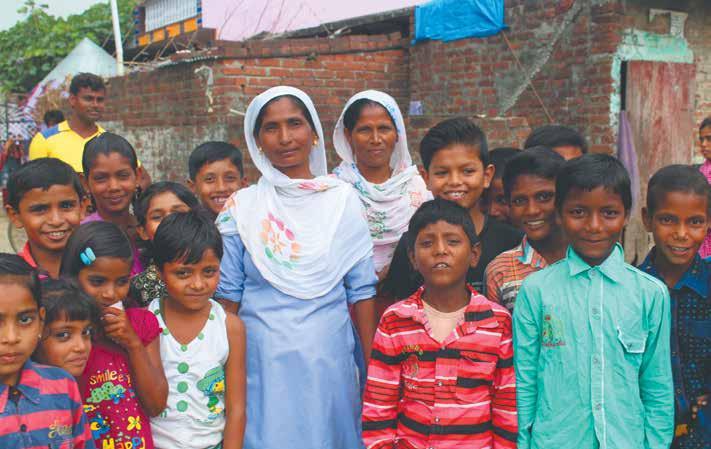
4 minute read
COLLABORATION AND COMMUNITY
Navihan (centre) is a health leader advocating for safter access to clean water in her community. This image was taken prior to the pandemic. © Matthew Smeal
ONE YEAR ON
CONTINUING THE FIGHT AGAINST COVID-19
It is the anniversary nobody wants to celebrate: a year since the first recorded cases of COVID-19. Passing a milestone year of crisis, the need for accessible and effective healthcare has come into sharp focus. India remains one of the hardest hit countries, with daily infection rates surpassing the total of infections in Australia on some of India’s worst days.
Healing Fields Foundation, Opportunity’s health program partner in India, has continued to provide essential services to remote communities who would be unable to otherwise access care due to travel restrictions. General Manager of the Healing Fields Foundation, Gayathri Prashanth has helped lead the charge as the organisation faces down continuing risks from COVID-19. “The obvious challenges that have been well documented and acknowledged are increased poverty and hunger,” she said. “A lack of access to already scanty healthcare had direct impacts on our work both in the short term and long term, as we had to pivot to providing access to basic services like food. Access to healthcare was always a challenge, now, that has become much larger.” Even now, there are still new battles to face. With monsoonal rains and travel restrictions limiting access to villages, community health leaders are leading the way where program staff are unable to. “Trained [leaders] can continue to act as conduits for information and care,” Ms Prashanth said. “We are working to build local self-sustainability by helping communities to take responsibility for their health… as well as educate on COVID best practices and form committees for local COVID response leadership.” As government-imposed lockdowns caused cities to shut their doors and send workers away, a mass movement of stood-down workers began making their way home to villages, presenting a significant risk of the disease spreading. What first began as ‘dignity journeys’ quickly shifted to assisting the establishment of safe quarantine locations. “We had to start thinking and doing things on our feet,” Ms Prashanth said. “We regrouped and built ourselves to deliver information, knowledge and health education through channels we didn’t think were available or usable earlier.” While most workers have returned settled into their homes, the need for health leaders to continue providing information and support remains. Healing Fields’ health leaders – officially known as Community Health Facilitators (CHF’s) – have shifted their programs to address the gaps. “We were not able to

continue with our regular programs, and staff were also not able to travel due to the restrictions… instead of expanding existing programs, we’ve had to engage existing CHF’s in new, dynamic ways to approach the current scenario,” Gayathri said. “We immediately engaged with our CHF’s and pivoted our COVID response with them. Once again, the women rose to the challenge and worked closely with our team to protect the vulnerable, support the poor during lockdown, and help people access healthcare and government entitlements."
Further innovation led to new solutions to the reality of longterm travel limitations, with plans to implement new solutions in the months to come. “[Restrictions] got us thinking that we need to come up with a long-term sustainable solution to address the lack of access to primary care and consultation. It made us start thinking of a handheld mobile device in the hands of the trained CHF’s in the village can create access to qualified health providers remotely. I think if made simpler, this could potentially be a game changer in impoverished communities all across the world.” While handheld care assistance is still in the works, technology continues to play a vital role in supporting health leaders in remote areas. Using apps like WhatsApp and Zoom to stay in touch, and provide specialised assistance, technology is helping provide COVID-specific training in what Gayathri calls ‘the three P’s;’ “we are working towards COVID preparedness in villages along with our health leaders using the 3 P model; to prevent, protect, and prepare. The current focus is preparing villages through COVID management committees and applying the 3 P strategy.” More than 350 villages have formed COVID-safe committees, along with providing masks and food assistance to meet immediate needs. Gayathri noted that “the organisation has been able to greatly expand its impact in rural villages” due to the pandemic, with hopes to include an online education program for children of health leaders unable to attend school during lockdown. There is a chance to build a ‘new normal’ as vaccines roll out throughout the year, but it is no panacea for rural and remote communities. Unable to store some vaccines at temperatures so low that they require an industrial freezer, even transporting a fridge to store vaccines brings untold challenges. For now, health leaders continue to train and collaborate virtually with the Healing Fields team. The challenges are palpably real, but Gayathri remains hopeful that the new year will bring change for the good. “We are hoping that schools can begin in the next academic year, so we can focus on our school health programs. We are hoping to see the communities we work in build resilience, not just to fight this pandemic, but to overcome challenging situations in the future,” she said.
Dasih washes her hands at a sanitation station installed by our program partners in Indonesia. Image courtesy of KOMIDA
Women making sanitary pads wear masks and gloves, common personal protective equipment to prevent the spread of COVID-19 and other diseases. © Matthew Smeal







